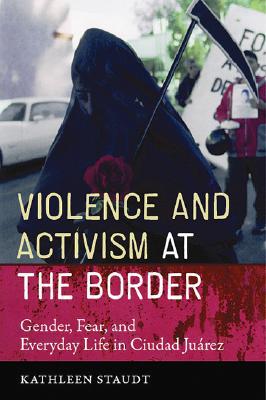

 |

|

The average rating for Violence and activism at the border based on 2 reviews is 4 stars.
Review # 1 was written on 2009-01-10 00:00:00 Nikolas Porter Nikolas PorterOn the website for the National Organization for Women you can find the definition of femicide, "the mass murder of women simply because they are women.” Prior to reading Violence and Activism at the Border, I had not come across this term. Although it was created specifically in response to the violence in Ciudad Juarez, it did not seem particularly foreign to me either. Kathleen Staudt, a professor of Political science at the University of El Paso, chronicles the events that eventually gave birth to that term, and the response that came from both community members and people around the world. Ciudad Juarez is a Mexican border town where, between 1993 and 2003, more than 370 young girls and women were murdered, their bodies found in Ciudad Juarez and the surrounding area. Living in El Paso, Staudt is accustomed to sensationalized media reports of the murdered women and children whose bodies are often found mutilated, and whose police cases go unsolved. She is critical of the inadequate response from police forces and politicians on both sides of the border. However, throughout the course of the book, she is careful to show that these murdered women are no exception to the violence against women that occurs all around the globe. The violence that Staudt sets her gaze on is a penetrating daily violence that permeates women’s day to day lives in Ciudad Juarez, El Paso, and countless other cities. It is from here that Staudt begins to conceptualize the reparative and preventative work that is being done in the community of Ciudad Juarez and among the global networks being created, as well as the performative nature of gender-based activism. In Staudt’s account, the peak of the movement against femicide in Ciudad Juarez was during V-Day in 2004, a global event organized in large part by Eve Ensler, the author of The Vagina Monologues. It was at this event that thousands participated in reenactments of the play, as well as protests throughout the streets of Juarez. However, despite the overwhelming turnout to this event, participation in the movement has since declined. Staudt’s underlying argument in her analysis of V-Day is that in order to prevent further violence against women, including femicide, it is vital to understand the link between the grotesque murders that have occurred in the past two decades and the everyday normalization of violence against women in Ciudad Juarez and around the world. It is not enough to respond to sensationalized news reports of grisly murders. Rather, it is crucial to establish lasting global networks that aim to combat violence against women around the world. Staudt provides an excellent account of the proliferation of violence against women, and she works toward a sustainable movement that will last across generations and across borders. It would be nice to think that there should be no need for femicide in our dictionaries because there should be no place for it in our lives. Review by Lizzy Shramko |
Review # 2 was written on 2009-05-15 00:00:00 Terrence Johnson Terrence JohnsonFor the author, gender is an importunate motif underscoring many relationships in this society and without. Staudt heads up a far more adventurous path. Rather than falling into clichés that would otherwise relegate it to blogosphere protoanalysis, Staudt talks about femicide in Juarez as a tragedy in which governmental failure and civilian complicity on many levels have linked with profit to a conspiracy of silence unlike anything else in Mexico. Such fears have been expressed before, but rarely so passionately as they are in Activism. Notions of female subservience captured in images like La Malinche, valid though quaint, are not clearly contextualized in either work, brave attempts notwithstanding. There is no denying there may be particularly sexist qualities in Mexican or Latin American culture. But while economic globalization is seen as a major source of Ciudad Juarez’s miseries, global systems of patriarchy are largely spared the same rebuke. As another University of Texas Press release, Drugs, Thugs, and Divas: Telenovelas and Narco-Dramas in Latin America by O. Hugo Benavides, acknowledges, popular culture plays on racialized notions of Mexican/Latin American men (and, by extension, Black men and men of color generally) as distinctly macho, brash and disrespectful of women in ways white men are not. This sort of positioning often occurs absent of history. While Frantz Fanon astutely pointed out postcolonial societies without a strong understanding of race and class are doomed to repeat the mistakes of their colonial overseers, putting the proper context to thoughts that postcolonial societies are somehow more primitive in their approach to issues like gender misses the point of understanding dependency theory and cultural imperialism. Whiteness pervades Mexican culture as much as in any other postcolonial country, and its impact on race, class and gender is more forcefully thrashed out elsewhere. |
CAN'T FIND WHAT YOU'RE LOOKING FOR? CLICK HERE!!!